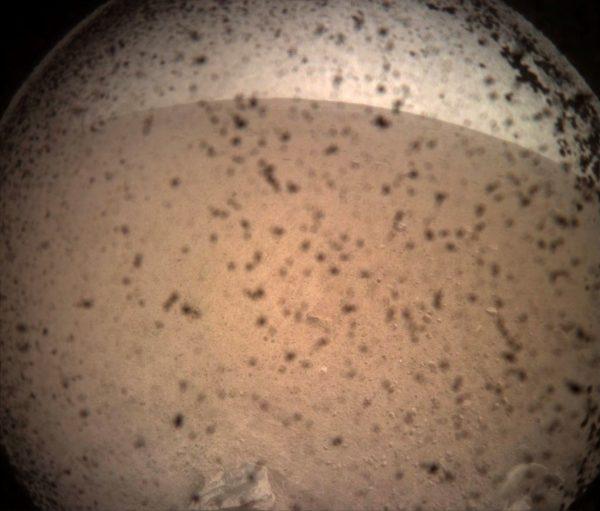PASADENA—NASA’s Mars science lander InSight touched down safely on the surface of the red planet on Monday to begin its two-year mission as the first spacecraft designed to explore the deep interior of another world.
Engineers at the Jet Propulsion Laboratory (JPL) near Los Angeles burst into cheers and applause as they received signals confirming InSight’s arrival on Martian soil—a vast, barren plain near the planet’s equator—shortly before 3 p.m.
Minutes later, JPL controllers received a fuzzy photograph of the probe’s new surroundings on the red planet, showing the edge of one lander leg beside a rock.

The landing data and first image were relayed to Earth from one of two miniature satellites that were launched along with InSight and were flying past Mars as it reached its destination.
The landing capped a six-month journey of 301 million miles from Earth, following InSight’s launch from California in May.
Carrying instruments that detect planetary heat and seismic rumblings, the stationary lander streaked into the thin Martian atmosphere at 12,300 miles per hour.
Its 77-mile descent was then slowed by atmospheric friction, a giant parachute, and retro rockets, bringing the three-legged spacecraft to a gentle landing within seven minutes.
Once landed, the stationary probe was programmed to pause for 16 minutes for the dust to settle, literally, around its landing site, before two disc-shaped solar panels were to be unfurled like wings to provide power to the spacecraft.
But scientists did not expect to verify successful deployment of the solar arrays for at least several hours.
The 880-pound InSight—its name is short for Interior Exploration Using Seismic Investigations, Geodesy, and Heat Transport—marks the 21st U.S.-launched Mars mission, dating back to the Mariner fly-bys of the 1960s. Nearly two dozen other Mars missions have been sent from other nations.
Peering Beneath The Surface
InSight will spend 24 months—about one Martian year—collecting data to unlock mysteries about how Mars formed and, by extension, the origins of the Earth and other rocky planets of the inner solar system.InSight’s primary instrument is a French-built seismometer, designed to record the slightest vibrations from “marsquakes” and meteor impacts around the planet. The device, to be placed on the surface by the lander’s robot arm, is so sensitive it can measure a seismic wave just one half the radius of a hydrogen atom.
Scientists expect to see a dozen to 100 marsquakes during the mission, producing data to help them deduce the depth, density, and composition of the planet’s core, the rocky mantle surrounding it, and the outermost layer, the crust.
The NASA Viking probes of the mid-1970s were equipped with seismometers, too, but they were bolted to the top of the landers, a design that proved largely ineffective.
A second instrument, furnished by Germany’s space agency, consists of a drill to burrow as deep as 16 feet underground, pulling behind it a rope-like thermal probe to measure heat flowing from inside the planet.
Meanwhile, a radio transmitter will send back signals tracking Mars’ subtle rotational wobble to reveal the size of the planet’s core and possibly whether it remains molten.
NASA officials say it will take two to three months for the main instruments to be deployed and put into operation.
InSight and the next Mars rover mission, scheduled for 2020, along with others in the planning stage, are seen as precursors for eventual human exploration of Mars, NASA officials said.





